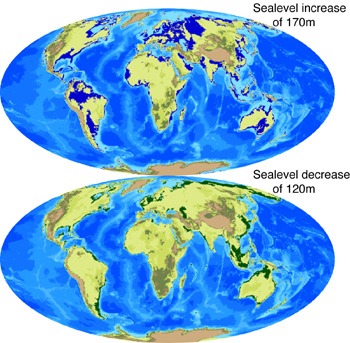Cretaceous sea levels were 550 feet higher than today
Cretaceous sea levels were 550 feet higher than today
mongabay.com
March 6, 2008
Sea levels were 550 feet (170 m) higher in the late Cretaceous period, about 80 million years ago, than today, shows a new reconstruction of historic ocean basins published in the journal Science. The authors say the work may help model current global warming-driven sea level change.
 Figure 1 (top) illustrates the effect of a 170 m sea level rise on today’s continents (dark blue), equivalent to the 170 m sea level maximum we model at 80 million years ago in the Cretaceous period. This is based on combined changes in ocean basin volume and the melting of all present day ice sheets in the hothouse climate that existed in the Cretaceous. Figure 2 (bottom) illustrates what the world may look like 80 million years into the future, with sea level being 120 m lower than today (exposed land shown in dark green). This is what we expect as the ocean basin volume will continue increasing, as it has for the previous 80 million years, due to the aging and deepening of the oceans. If, however, the current inland ice caps partially or entirely melt, then this projected long-term sea level drop will be alleviated by up to about 50 m. However, even in an ice-free world 80 million years into the future, we would see a net projected sea level drop of about 70 meters. Image courtesy of R. Dietmar Müller |
Analyzing data on ocean crust production, ocean sediment buildup and tectonic plate boundaries to reconstruct ancient ocean basins, R. Dietmar Müller of the University of Sydney and colleagues modeled a late Cretaceous sea level that was 550 feet (276-878 feet) [170 (85 to 270) meters] higher than it is today. The estimates center around geological changes near New Jersey, where plate movement might have pulled the Jersey coast downward by 340-585 feet (105 to 180 meters) in the past 70 million years. Müller and colleagues says the results “could help reconcile different Cretaceous sea level estimates from the area” as well as improve forecasting for sea level change due to warming climate.
“A combination of a global ocean basin volume analysis with modern geodynamic models provides a powerful tool for discriminating eustasy from regional, time dependent sea-level variations caused by mantle convection. Our global sea-level curve calibration provides an improved framework for sequence stratigraphy, resource exploration, and models for long-term climate change,” the authors write.
The study suggests that the current rise attibuted to thermal expansion of sea water and melting ice is but a brief interruption of an broader geological trend toward deeper oceans. Overall the authors forecast a sea level decline of 120 meters over the next 80 million years.
R.D. Muller et al (2008). Long-Term Sea-Level Fluctuations Driven by Ocean Basin Dynamics. Science 07 March 2008.